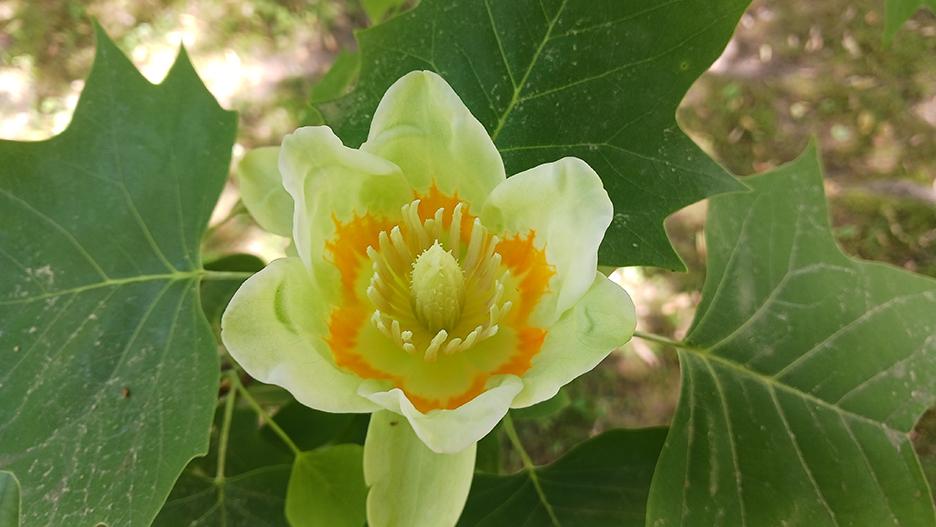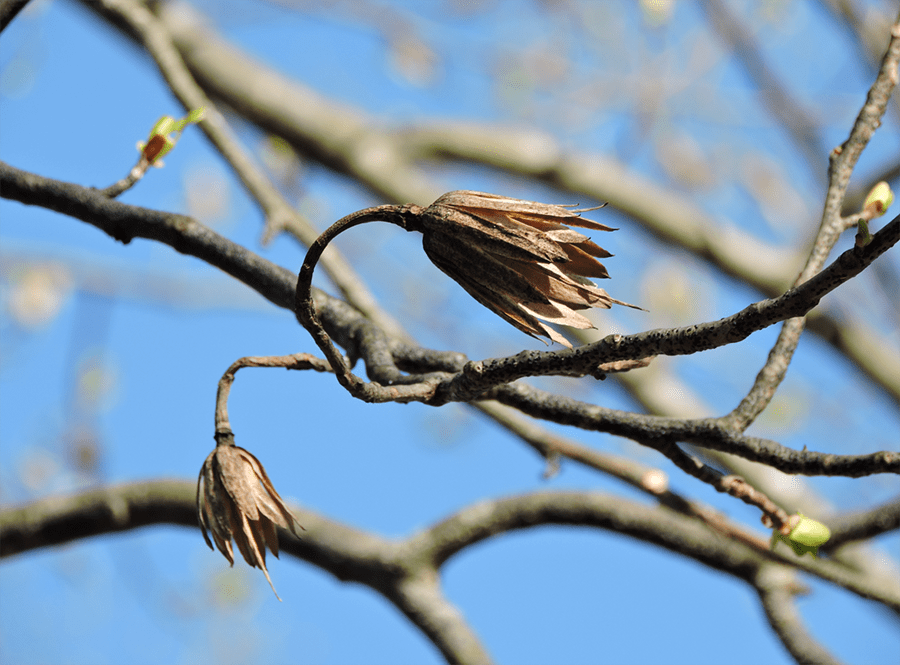John Hooven, UME Forest Stewardship Educator
Tuliptree (Liriodendron tulipifera) leaf
Maryland is full of remarkable tree species. The state’s latitude, its proximity to the Atlantic coast, and its elevation change from sea level in the east to the Appalachian Mountains in the west make the landscape here the perfect host for a diverse array of tree species. The tuliptree, Liriodendron tulipifera, is one of the tallest of these trees, and one of the tallest of the deciduous trees in North America. Another common name for the tree is tulip poplar, or yellow-poplar, but it is not a member of the poplar genus Populus, nor in the family that hosts poplar, Salicaceae. It does, however, exhibit characteristics similar to Poplar. But it is a member of the Magnolia family, Magnoiliaceae.
Tuliptree is a splendid tree but not recommended for small or compact yards. It quickly grows straight and tall and can reach heights of 44 – 61 feet in 20 years. Under the best site conditions, tuliptree can reach heights of 200 feet with a diameter at breast height of 8 – 12 feet. It is more commonly found growing to 100 – 150 feet in height with a diameter of 2 – 5 feet. Tuliptree is not affected by many pests and is relatively long lived in the forest. Trees can live to be 200 – 250 years but have been known to live to 300 years. It is considered shade intolerant. But it can outcompete other tree species and quickly establish itself in the forest canopy.


Tuliptree produces arguably one of the most beautiful flowers of our native trees. Six-petalled flowers emerge in the spring for two to six weeks and are very distinct, typically yellow to greenish yellow with a cantaloupe orange wavy band. Flowers emerge on trees around 20 years in age but may continue flowering for 200 years. Cross-pollination by insects is very important but it is not uncommon for self-pollination to also occur. The fragrant flowers can at times be underappreciated, as they typically occur high in the canopy of mature trees in the forest. But the flowers produce quite a bit of nectar and are excellent in the production of honey from honeybees. The resulting seed pods are distinct and make the tree easy to identify. The seeds are readily eaten by wildlife when dispersed.
Another distinctive feature of the tuliptree is its leaf. The leaf is simple on a long petiole with 4 lobes. The leaf somewhat resembles the silhouette of a fox’s head when viewed face on. The bark is brown, deeply furrowed when mature, and fragrant. The tree provides excellent shade in the landscape. Tuliptree has terrific value as an ornamental tree where enough room allows it to grow. These attributes aside, the tree is also highly valued for its usefulness as timber. The wood is used for furniture production, veneer, plywood and also as pulpwood. While young stems are vulnerable to fire in the landscape, mature trees have a thick, insulating bark that is excellent protection from fire.
The tree is a host to the tulip-tree beauty moth, Epimecis hortaria, whose common name is derived from its larvae association with the tree. However, the moth’s larvae will actually feed on other genus, including Sassafras, Populus, Magnolia and Asimina (paw paw). Whether in the garden landscape or the forest, tuliptree is a wonderful asset to have in the landscape.
Sources:
Burns, R. and Honkala, B. Silvics of North America Volume 2. Hardwoods. United States Department of Agriculture (USDA), Forest Service, Agriculture Handbook 654.
Wikipedia contributors. "Liriodendron." Wikipedia, The Free Encyclopedia. https://en.wikipedia.org/wiki/xLiriodendron_tulipifera
Branching Out, Vol. 32, no. 2 (Spring 2024)
Branching Out is the free, quarterly newsletter of the Woodland Stewardship Education program. For more than 30 years, Branching Out has kept Maryland woodland owners and managers informed about ways to develop and enhance their natural areas, how to identify and control invasive plants and insects, and about news and regional online and in-person events.
 English
English العربية
العربية Български
Български 简体中文
简体中文 繁體中文
繁體中文 Hrvatski
Hrvatski Čeština
Čeština Dansk
Dansk Nederlands
Nederlands Suomi
Suomi Français
Français Deutsch
Deutsch Ελληνικά
Ελληνικά हिन्दी
हिन्दी Italiano
Italiano 日本語
日本語 한국어
한국어 Norsk bokmål
Norsk bokmål Polski
Polski Português
Português Română
Română Русский
Русский Español
Español Svenska
Svenska Català
Català Filipino
Filipino עִבְרִית
עִבְרִית Bahasa Indonesia
Bahasa Indonesia Latviešu valoda
Latviešu valoda Lietuvių kalba
Lietuvių kalba Српски језик
Српски језик Slovenčina
Slovenčina Slovenščina
Slovenščina Українська
Українська Tiếng Việt
Tiếng Việt Shqip
Shqip Eesti
Eesti Galego
Galego Magyar
Magyar Maltese
Maltese ไทย
ไทย Türkçe
Türkçe فارسی
فارسی Afrikaans
Afrikaans Bahasa Melayu
Bahasa Melayu Kiswahili
Kiswahili Gaeilge
Gaeilge Cymraeg
Cymraeg Беларуская мова
Беларуская мова Íslenska
Íslenska Македонски јазик
Македонски јазик יידיש
יידיש Հայերեն
Հայերեն Azərbaycan dili
Azərbaycan dili Euskara
Euskara ქართული
ქართული Kreyol ayisyen
Kreyol ayisyen اردو
اردو বাংলা
বাংলা Bosanski
Bosanski Cebuano
Cebuano Esperanto
Esperanto ગુજરાતી
ગુજરાતી Harshen Hausa
Harshen Hausa Hmong
Hmong Igbo
Igbo Basa Jawa
Basa Jawa ಕನ್ನಡ
ಕನ್ನಡ ភាសាខ្មែរ
ភាសាខ្មែរ ພາສາລາວ
ພາສາລາວ Latin
Latin Te Reo Māori
Te Reo Māori मराठी
मराठी Монгол
Монгол नेपाली
नेपाली ਪੰਜਾਬੀ
ਪੰਜਾਬੀ Afsoomaali
Afsoomaali தமிழ்
தமிழ் తెలుగు
తెలుగు Yorùbá
Yorùbá Zulu
Zulu ဗမာစာ
ဗမာစာ Chichewa
Chichewa Қазақ тілі
Қазақ тілі Malagasy
Malagasy മലയാളം
മലയാളം සිංහල
සිංහල Sesotho
Sesotho Basa Sunda
Basa Sunda Тоҷикӣ
Тоҷикӣ O‘zbekcha
O‘zbekcha አማርኛ
አማርኛ Corsu
Corsu Ōlelo Hawaiʻi
Ōlelo Hawaiʻi كوردی
كوردی Кыргызча
Кыргызча Lëtzebuergesch
Lëtzebuergesch پښتو
پښتو Samoan
Samoan Gàidhlig
Gàidhlig Shona
Shona سنڌي
سنڌي Frysk
Frysk isiXhosa
isiXhosa